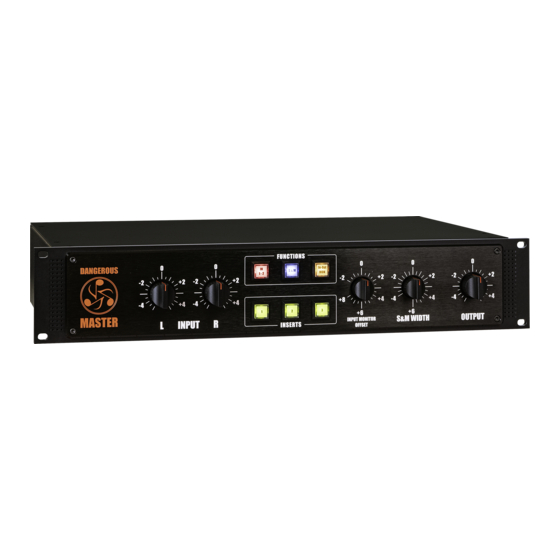Dangerous Music Master Manuale d'uso - Pagina 5
Sfoglia online o scarica il pdf Manuale d'uso per Apparecchiature di registrazione Dangerous Music Master. Dangerous Music Master 16.
Anche per Dangerous Music Master: Manuale di installazione e funzionamento (8 pagine)

MASTER |
1
OVERVIEW
The Dangerous MASTER is simple to install and operate. Designed to harness analog outboard processing,
a D/A or analog source, and an A/D feeding your DAW it becomes the centerpiece of your mastering rig.
Send an analog source to one of the inputs. Adjust them in separate 0.5dB increments of gain control to
precisely set the level and balance into the insert stack.
The inserts are to include analog processing equipment. It has been found by the authors after extensive
experimentation that 3 insert loops provide the correct number of insert points to get the job done. More
equipment is accommodated by ganging or adding a Dangerous Music LIAISON. The insert points can be
run to a patchbay if the added flexibility of patching is desired (to re-route the order of processing for
instance). Of course, more connectors and cable may not equal better sound quality.
The ' A C IN' connector goes to the power supply. Please check that the supply is off before plugging in this
cable. Hot plugging will result in burned contacts (like in your former life).
The writer's favorite suggested processing goes like this:
Insert 1 gets a stereo EQ to set the tone correct for the rest of the stack.
Insert 2 gets a parametric EQ, De-Esser, and Limiter to fix any problem with a mix.
Insert 3 gets a Compressor to control dynamic range for loudness.
The Output Gain control let's one precisely 'hit' the A/D converter at the correct level.
The Input/Output Monitor Selector let's one compare the dry and processed signal and there is an Input
Monitor Offset control so that comparison can be made even after adding several dB of loudness to the
mastered signal. This also allows an easy way to tell how much apparent loudness has been added to
the signal (by matching the apparent levels and reading the difference on the INPUT MONITOR OFFSET
gain control).
